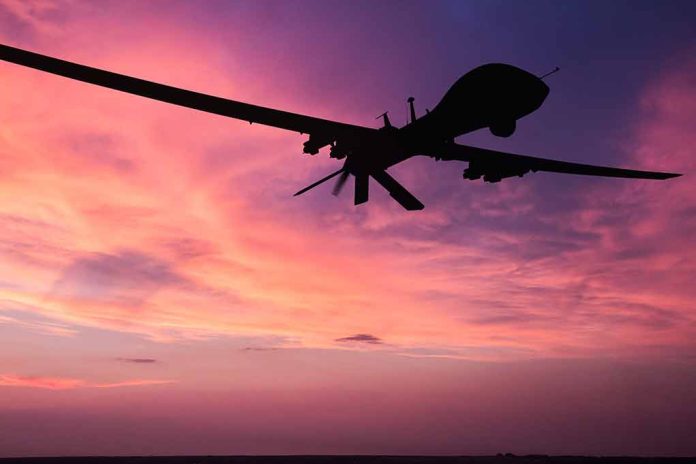
US Army’s innovative 3D-printed surveillance drones will slash costs by 90% while detecting invisible enemy threats that traditional cameras miss.
Key Takeaways
- The US Army is testing 3D-printed drones in Poland that can detect electromagnetic signatures from cell phones, routers, and radars, providing critical intelligence unavailable to conventional surveillance.
- These soldier-developed drones cost between $2,000-$3,000 each, compared to $28,000 for traditional military drones – a cost reduction of approximately 90%.
- On-site manufacturing capability reduces dependence on foreign components and accelerates deployment timelines for mission-specific requirements.
- The program represents a significant shift in military procurement strategy, prioritizing rapid innovation and cost-efficiency over traditional defense contractor relationships.
Game-Changing Technology for Battlefield Intelligence
The US Army is revolutionizing battlefield surveillance with cost-effective 3D-printed drones designed to detect electromagnetic signatures invisible to standard observation methods. Developed by soldiers from the 2nd Multi-Domain Effects Battalion stationed in Germany, these innovative aircraft will undergo critical field testing in Poland this month. Unlike conventional surveillance drones that rely solely on cameras, these specialized units can identify and track electronic emissions from enemy devices, including cell phones, WiFi routers, and radar systems.
“The main way I see adversaries is through their electromagnetic signature,” said Lt. Col. Aaron Ritzema, commander of the 2nd Multi-Domain Effects Battalion. “What I want to do is replicate what one of those adversary capabilities would look like in the spectrum.”
This capability marks a significant tactical advantage, as modern warfare increasingly relies on electronic communications that leave detectable signatures. The technology enables American forces to identify potential threats before they become visible through conventional means, providing commanders with enhanced situational awareness and decision-making capabilities. The upcoming Poland exercise will determine whether these drones meet operational standards and can be deployed at scale.
Dramatic Cost Reduction Through Innovation
Perhaps the most revolutionary aspect of this program is the dramatic cost reduction achieved through additive manufacturing techniques. Traditional military-grade surveillance drones typically cost approximately $28,000 each when purchased through defense contractors. In stark contrast, these 3D-printed alternatives cost between $2,000 and $3,000 per unit – representing savings of roughly 90%. This cost efficiency enables the Army to deploy larger drone fleets within existing budget constraints.
The battalion’s innovation lab, led by Sgt. 1st Class Tyler Baumgartner, developed these drones largely through self-taught expertise. “When we stumbled upon an issue, either we sourced to friends and partners for a solution, or we spent a copious amount of hours self-studying to develop a solution on our own,” he told Task & Purpose.
This grassroots approach to military technology development represents a significant departure from traditional procurement methods that typically rely on established defense contractors. By empowering soldiers to create solutions that address their specific operational needs, the Army is fostering a culture of innovation that could transform how military technology is developed and deployed in the future.
Overcoming Procurement and Supply Chain Challenges
Despite the project’s impressive technological achievements, soldiers faced significant bureaucratic obstacles throughout the development process. The team encountered lengthy approval and funding delays from the Department of Defense, with paperwork processes taking between 90 to 120 days. These administrative hurdles highlight the tension between traditional military procurement systems and the need for rapid innovation in modern warfare environments.
“Chief Warrant Officer 2 Chris Lehr told Task & Purpose, “What we know to be true now is that there are never enough [drones]. There’s never enough of them on the forward line of troops. There’s never enough of them in production.”
Sourcing electronic components presented another major challenge, particularly due to restrictions on procurement from certain countries. When asked about components made in China, Lt. Col. Ritzema cryptically responded, “Something like that.” These limitations forced the team to seek alternative suppliers, often at higher costs. The 3D printing approach mitigates some of these issues by reducing dependence on foreign-made drone airframes, though electronic components remain a challenge.
Future Applications and Strategic Importance
The Army views this initiative as just the beginning of a broader transformation in military technology development. The US Army Futures Command is already exploring autonomous mass drone production using additive manufacturing techniques. This approach could fundamentally change how military equipment is produced, moving from centralized manufacturing by defense contractors to distributed, on-demand production near areas of operation, significantly reducing logistics requirements and accelerating response times.
While initial tests faced setbacks, continuous improvements have brought the program to a critical juncture. Chief Warrant Officer 2 Chris Lehr described the effort as a “work in progress,” acknowledging both the challenges and potential of this innovative approach. The upcoming field exercises in Poland represent a crucial test not only for the technology itself but for the entire concept of soldier-led innovation in military equipment development.
“At an exercise in Poland this month, the branch will test small 3D printed drones for surveilling potential threats that cannot be detected with a camera alone,” said US Army officials
President Trump’s administration has consistently emphasized military readiness and technological superiority while demanding greater fiscal responsibility from defense programs. This initiative perfectly aligns with both objectives – enhancing battlefield capabilities while dramatically reducing costs. Furthermore, by reducing dependence on foreign suppliers, particularly from potential adversaries like China, the program supports broader national security goals of supply chain resilience and technological independence.







